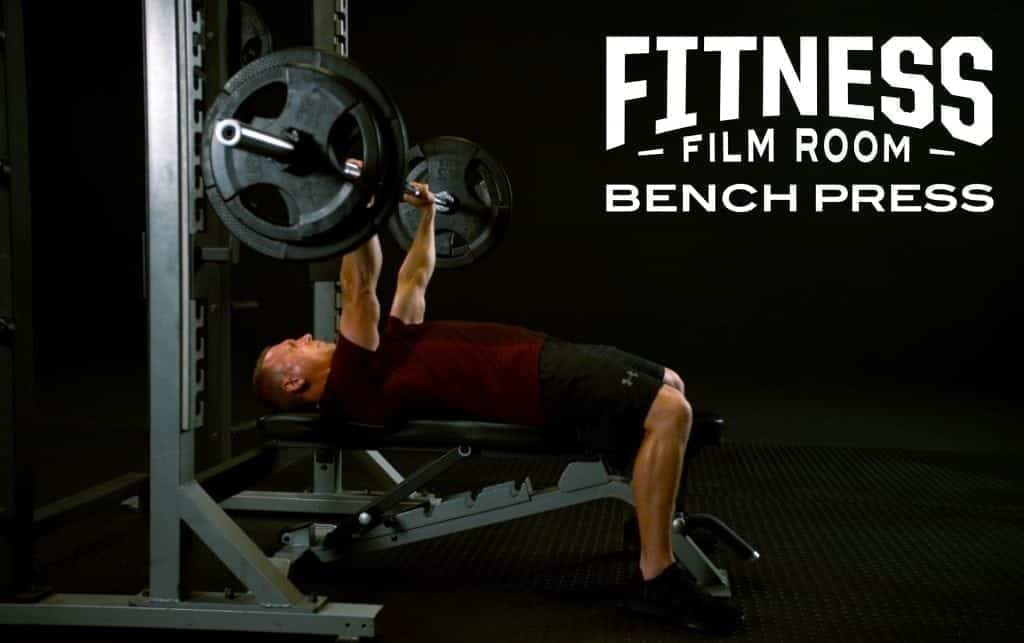
Ah, the bench. The classic weight room exercise. Get your form right, so you can reap the maximum benefits.
The post How to Bench Press appeared first on Under Armour.
from Under Armour https://undrarmr.co/2KdDuyT
https://undrarmr.co/2mYOMxG

Ah, the bench. The classic weight room exercise. Get your form right, so you can reap the maximum benefits.
The post How to Bench Press appeared first on Under Armour.
Hi friends! How are ya? Hope you’re having a lovely morning. I’m catching a barre workout today, editing the podcast for tomorrow (be sure to catch it here!) and heading out swimming with the girls. Just living that Tucson summer life until school starts again!
Their back-to-school wardrobe got an awesome boost when their first Stitch Fix boxes arrived a couple of weeks ago. They’ve seen me get fixes for years now – since Liv was a tiny baby! – and would often ask where their boxes were. (Thankfully Mac and Mia was created so they could have a similar experience. We’ve done a few of their deliveries and love them.) When I told the girls that these Stitch Fix boxes were for them, they were soooo adorable and excited about it. They couldn’t wait to open them.
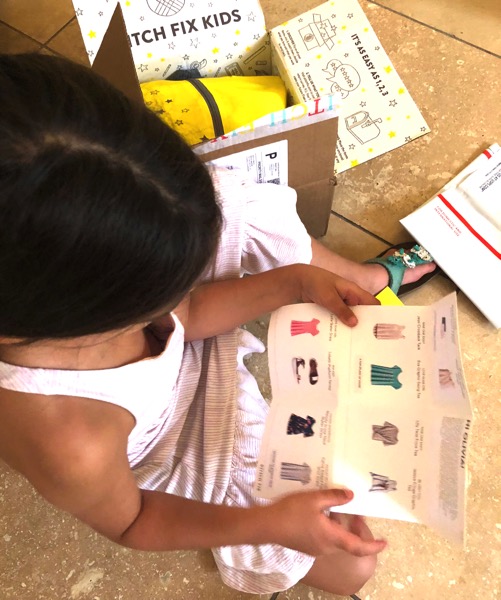

To be totally honest with you guys, my last few Stitch Fix deliveries have been a bit of a bummer. They sent me some weird pieces including a dress with intense palm tree print all over it, so I didn’t have super high hopes for the kids boxes. I thought maybe we’d keep a few things and just kind of get the feel for it, especially since it’s a newer service.
I was BLOWN AWAY by all of the amazing stuff they sent for the girls!

I had filled out their style profiles online and it was fun to note their personal preferences and the types of styles they usually enjoy. For example, Liv is a little more sporty than P, and also a little bit more adventurous on the fashion front. P only wants to wear dresses right now – she basically acts like she’s on fire if I try to suggest shorts and a top for her to wear – so they sent her quite a few new dresses in her fix.
Right away, Liv was stoked about the new rose gold sandals. The fit her perfectly and she’s been wearing them to church and out to dinner ever since.

She loved all of the clothes she received so much, we ended up keeping everything in her box. It was a fun mix of dresses for school, tops, shorts, and the beloved sandals.
P immediately started trying on all of the dresses in her box. She wore a beautiful red Kate Spade dress the rest of the day and was as happy as a little clam.

We ended up keeping almost everything in her fix, except for a pair of shorts and a top she’d never wear.

– They really paid attention to the notes in their style profiles. I had answered that a giraffe was Liv’s favorite animal, and she received a shirt with a giraffe on it. I feel like the fixes were extremely personalized for each girl.
– The price points!! I was expecting it to be expensive, especially since Mac & Mia is pretty pricey. I was surprised by the prices, because most of the shirts were $14 to $20 and the most expensive piece was P’s Kate Spade dress at $34.
– High quality. The clothes all felt like they were well-made and like they’d last playtime, school, and running around.
– CONVENIENCE. This is my #1 favorite thing about Stitch Fix: they pick items just for you that you can try on at home and send back what you don’t like. Shopping with the girls is a little crazy right now – they just toss things into the cart with wild abandon and I almost always forget the most important items on our list – but they still need new clothes. Trying on at home is a thousand times easier than lugging them to the mall, especially when they’d rather be playing or doing something fun.
If you’d like to try out Stitch Fix for kids, my referral link is here!
Friends with kiddos: where do you shop for school clothes? Do you shop with your kiddos or prefer to do it solo?
Where did you do most of your back-to-school shopping when you were a kid? I still remember Mervyn’s vividly haha.
Hope you have a great day and I’ll see ya in the morning with this week’s podcast episode all about acupuncture.
xo
Gina
The post Stitch Fix for Kids Review appeared first on The Fitnessista.
Hi friends! Happy Monday! How was the weekend? Ours was a great one. We spent a ton of time with family and friends, got to swim, and enjoyed some beautiful desert monsoons, so no complaining over here.
Friday night, the girls and I decided to enjoy dinner out, so we went to Commoner & Co. I wrote about this recently, but my brother Kyle has taken over as partner chef for Commoner and the popular brunch restaurant, Prep & Pastry. He completely revamped the menu at Commoner, so we were excited to check out the new menu options.
Kyle surprised us with this goat cheese tart while we were waiting for our entrees.
It’s a savory lemon thyme tart with fluffy brûléed goat cheese, served atop STRAWBERRY JAM. It was the perfect mix of sweet and savory… it was like my favorite bite from a cheese board (cracker, cheese, jam), completely elevated. It’s probably my new favorite food ever, and served with Kyle’s signature artistic presentation:
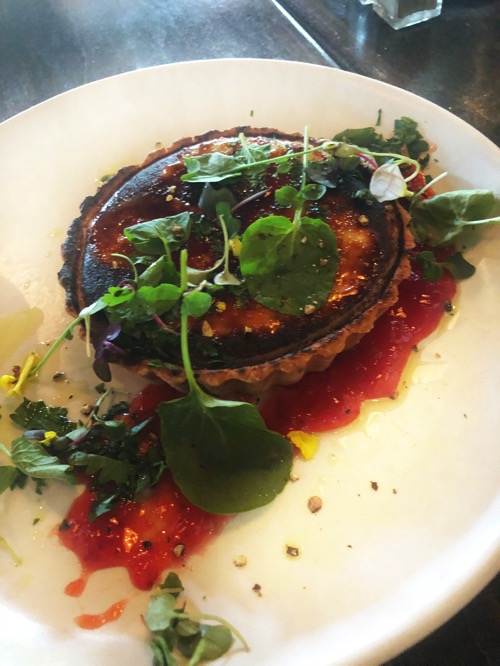
(Everything he makes looks almost too beautiful to eat)
For my entree, I rolled with the salmon, which is served on top of a bed of Spanish rice with veggies, olives, goat cheese, and Romesco.
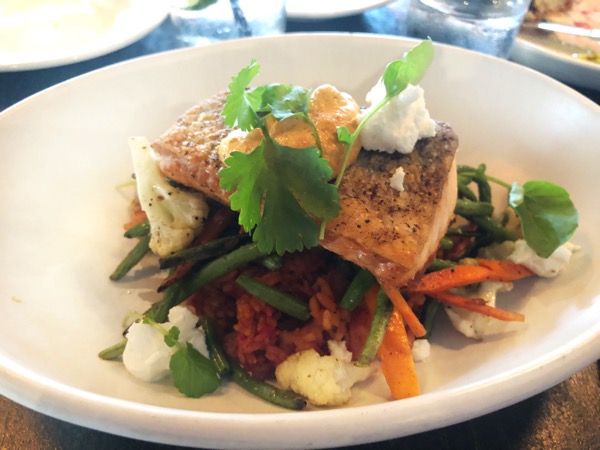
Kyle also brought out the deconstructed cake for dessert. It was bites of pistachio sponge cake, cream cheese frosting, and a bunch of other deliciousness I can’t really remember because Liv and P were on either side of me and we were shoveling bites into our mouths in pure bliss. It was everything.
Commoner and Co. was one of our favorite date night spots long before Kyle took over the kitchen. But I have to say that now that he’s there, it’s taken everything to the next level. Our dinner was my favorite meal we’ve had since we’ve been back in Tucson, which says a lot since we’ve eaten at a lot of amazing spots since we’ve been here. We’ll definitely be back soon.
After our incredible meal, we decided to head to Trail Dust Town. Like my friend Lindsay said, it’s like Oregon Trail Disney World. (With way less rides, but the girls still love it.)

We rode the covered wagon Ferris wheel and the carousel (which is unnervingly fast haha) and then walked around for a while, my nana met us there, so it was fun to walk around with her and check out the sights.
Saturday morning, I caught a leg and HIIT workout at the gym, and then we headed to a friend’s birthday party. The girls got to run around with all of their little friends and eat cupcakes, while I got to catch up with Meg and Lindy. After the party, we came home and watched the live version of Alice in Wonderland. I wouldn’t recommend it for a 2-year old – I kept hoping P would fall asleep on the couch, but instead she was intently watching to see if Alice would “slay the jabberwocky” *SMH – but it was definitely good.
After the movie, we went to the park for an hour and met my dad and stepmom at Bear Canyon Pizza for dinner.
Sunday was the usual church, errands, lunch with madre, then grilling/swimming at Uncle E’s.
I started reading Limelight, looking for something lighthearted and fun, and it’s fit the bill. Highly recommend it so far!

I hope you had a great weekend, too!
Today, I’m recording a podcast episode with a friend and subbing a class later this afternoon. Hope you have a happy Monday and I’ll see ya in the morning.
xoxo
Gina
The post weekending appeared first on The Fitnessista.
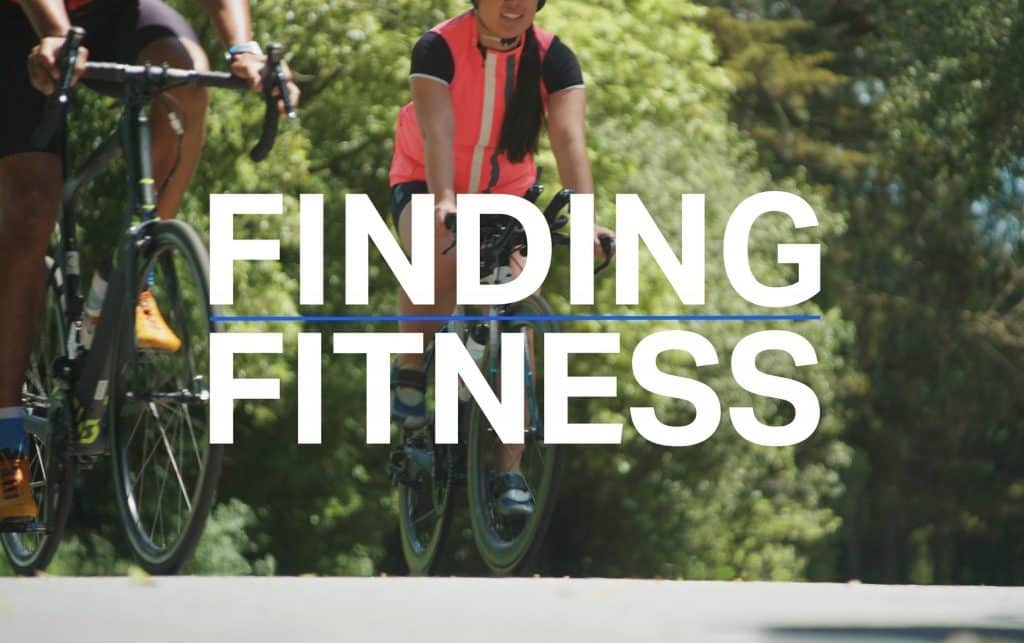
San Francisco is known for the Golden Gate Bridge and its hills, the latter making for a killer cycling workout.
The post Cycling the Golden Gate Bridge appeared first on Under Armour.
Hi friends! Happy weekend to ya. What’s going on this weekend? We’re looking forward to swimming with the fam, a birthday party, and catching a couple of fitness classes. We’re getting things ready for school and just enjoying chillin’ in the AC… far away from the insane heat. I’d love to hear what you’re up to!
It’s time for the weekly Friday Faves party! This is where I find some of my favorite finds, wears, reads, and treats from the week. Please share any faves you’re loving in the comments section if you’d like to join in the fun.
–The euphy!! I ordered this little beauty during the Amazon Prime sale and for real. It’s changed my cleaning life. I’m a huge fan of our Dyson cordless, which I use for spot-cleaning daily, but I hate dragging out our *regular* vacuum. This magical creation quietly zooms around the house capturing every speckle of dust, crumbs, and dog hair. REJOICE. I thought our floors were clean – we’d had professional cleaners a few days prior and I’d used the Dyson a few times – and then I ran this thing, and the ENTIRE CANISTER was full of dog hair. (Thanks, Caro.) Every time I open the canister, I feel like such a weirdo because I get genuinely happy to see everything it picks up. It’s the little things, right?
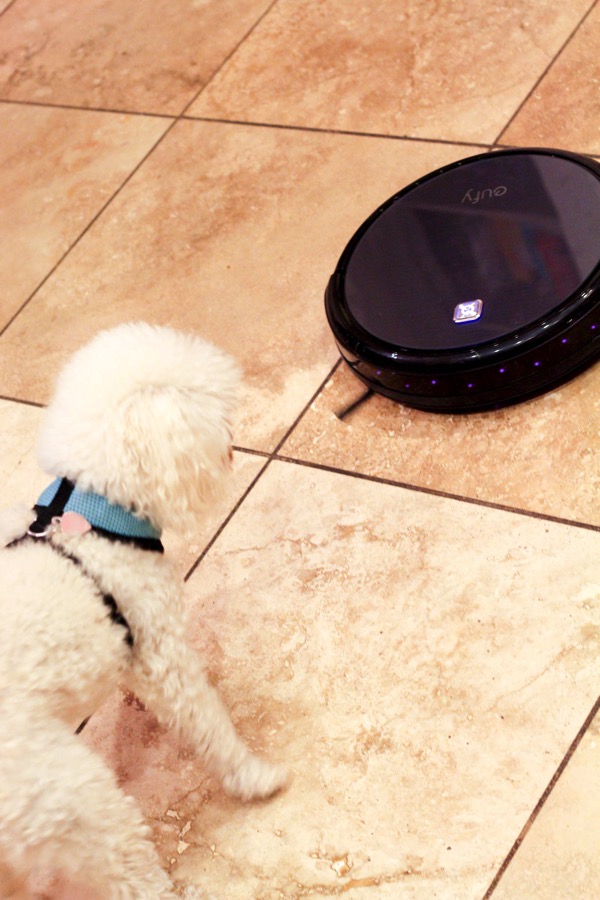
Poor Bella doesn’t like the euphy quite as much as I do.
– Playing tourist. I’ve had to get creative with activities for the girls because it’s so hot outside, so we’ve been playing tourist and visiting local attractions.

It was our first time checking out the Mini Time Machine Museum of Miniatures. It was SO COOL, and the girls loved it! They have various exhibits of contemporary and antique miniatures. There are ornate dollhouses with fully decorated rooms, an entire Christmas village, and a mystical fairy/troll.dragon area. They also have a scavenger hunt for the kiddos; you try to find their miniature fairy, Caitlin, who is hiding in five different areas of the museum. We found three of the fairies, and spent quite a bit of time checking out the exhibits.

– We also checked out the Flandrau Science Center and Planetarium at the U of A, which I haven’t visited since I was in elementary school. We were there for over 3 hours! The girls kept wanting to go around and around, and after tons of learning/exploring, we watched the laser light show in the planetarium theater. P fell asleep after about 20 minutes, but Liv was especially into the stories of Greek mythology and learning about constellations. She’s said she wants to be an astronaut when she grows up since she was like 3, so needless to say, we’ll be going back.

(P’s dress is 100% on backwards because she dresses herself now.)
– These Spanx leggings arrived from the Nordstrom sale and they’re a dream come true. Warning that they look very small out of the package – as most Spanx products do.. I find myself wondering how the heck I’m going to sausage myself into them – but they slide on and feel like nothing. They’re insanely flattering and soooo comfortable. I’ll definitely be wearing them a ton once the weather chills out.
Speaking of the Nordstrom sale, they’ve restocked quite a bit of my faves and still aren’t sold out of some others.
Here’s what’s left of the good stuff:
More colors and sizes in my fave leggings ever
Lots of sizes in this hooded long cardigan
Lovin’ the mesh detail on these cropped leggings
This dress would look so cute with booties
These plaid pajamas look amazing
Lots of colors and sizes in my fave bra ever. I got two more 
Super cute neutral flat bootie
Perfect time to stock up on Hanky Panky
Amazing deal on this wallet
Love this delicate bracelet as a gift idea
– Bahama Bucks. I mentioned this before, but if you’re in Tucson, you HAVE to go. They have so many flavors and you can add ice cream and sprinkles. I decided to venture outside of my usual birthday or wedding cake shaved ice and went with the fiesta flavors: cucumber, mango, and melón with chili salt. I want another one riiiiight now.

– Sheet pan dinners for the win. I haven’t felt much cooking gusto lately, but still managed to cook all week this week (minus Panera last night) with super simple dinners. For this one, I boiled the potatoes for about 10 minutes, then added them to a sheet pan with salmon, and asparagus.
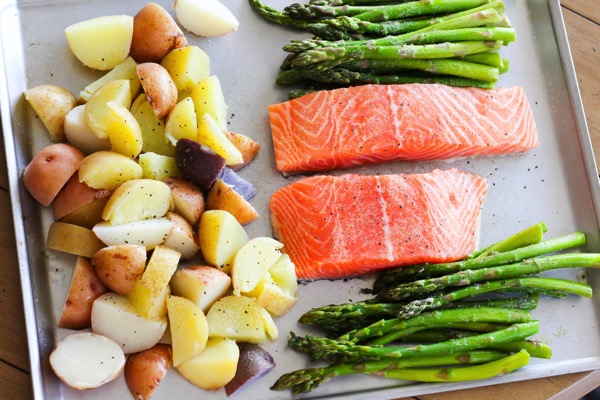
Everything was seasoned with avocado oil, garlic powder, salt, and pepper, then I added the Trader Joe’s vegan pesto on top of the salmon and baked everything for 15 minutes. Dinner: done. Clean-up was a breeze.
– 32 smoothie ingredients from Trader Joe’s
– If you’re looking for a leg workout, check out this one! It’s similar to the one I did the other day

– The Mamma Mia soundtrack. We’ve been listening to it all week, and Super Trouper is an instant mood booster.
– If you missed this week’s podcast episode, check it out here! My blog BFF Julie gave it such a great shout out in her post (+ lots of podcast suggestions).
– The Babysitter’s Club is coming back! Who was your favorite character? I was 100% team Claudia.
– This Motherhood Around the World series is fascinating
– Kind of obsessed with this random IG account
Happy Friday, friends!
xo
Gina
The post Friday Faves appeared first on The Fitnessista.
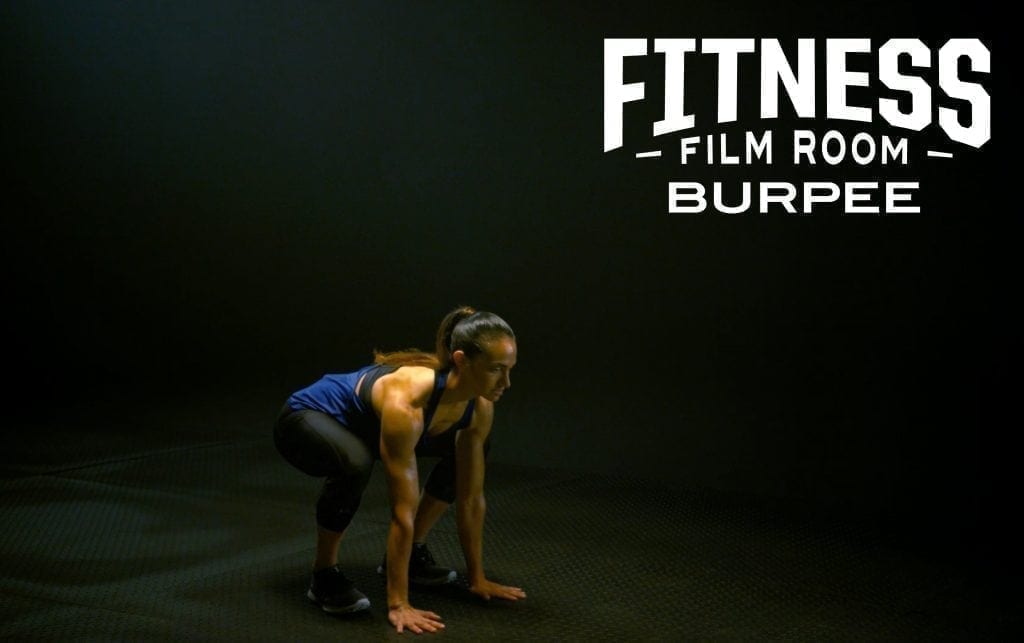
Burpees seem to be everyone’s favorite exercise to hate. We can’t promise you’ll hate them less after watching this, but let’s at least learn the proper form.
The post How to Burpee appeared first on Under Armour.
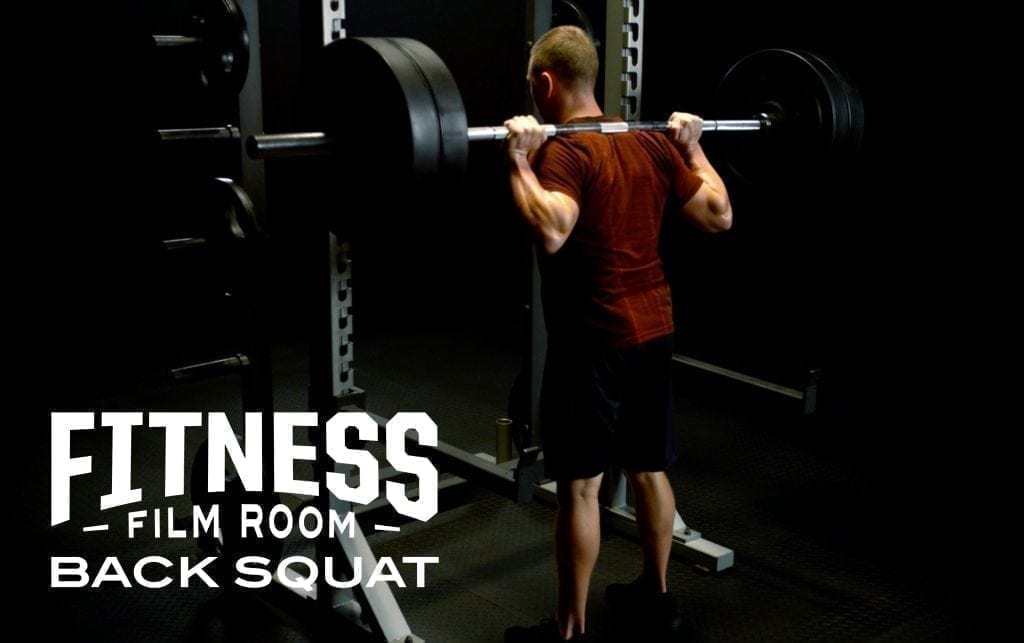
Squats are one of the best exercises for strengthening your legs, glutes, core and more. Without proper form, however, you’re missing out on all the benefits.
The post How to Back Squat appeared first on Under Armour.
This post is sponsored by Zappos.
Hi friends! Thank you so much for all of your amazing feedback on yesterday’s podcast episode. I’m so happy you enjoyed it, and I loved sharing some advice for creating a balanced fitness plan. I’ve been working on creating my own fitness plan now that we’re back in Tucson since I’m surrounded by great gyms + studio classes. My current routine consists of mostly Lean Machine strength workouts, classes (usually Orangetheory, dance cardio, or barre), HIIT, and reuniting with an old friend: running.

(Wearing: Array Long Sleeve Tee, Circuit 2 in 1 Short, Levitate 2 sneakers)
My relationship with more distance-style running tends to be on or off. (Sprints are almost always part of my fitness puzzle, but it’s been a couple of years since I’ve ventured out on consistent solo runs.) Something about being back in a familiar place with all of my favorite trails made me want to lace up my sneaks and hit the road, so I’ve been going for it.
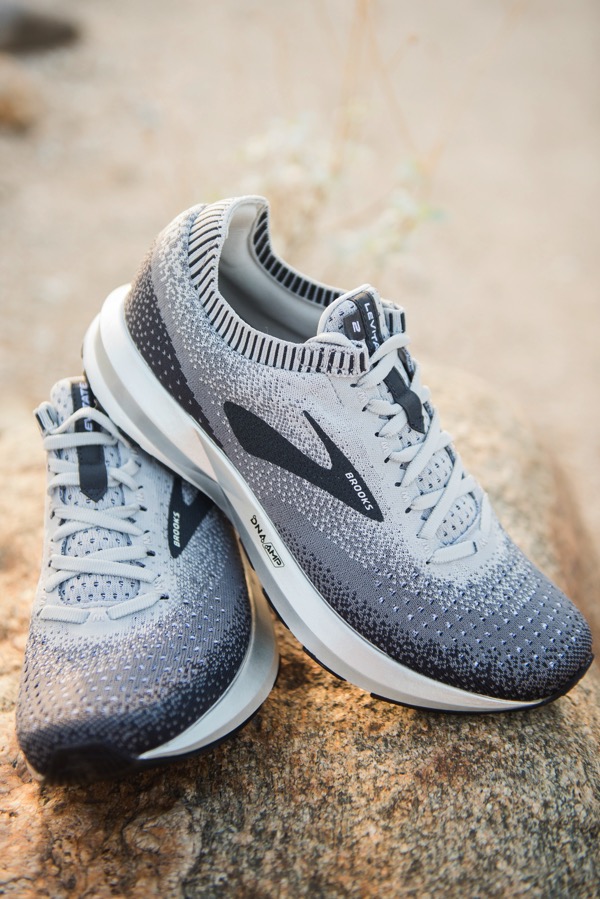
My friends at Zappos sent me a pair of Brooks’ new Levitate 2 sneakers to try out and they quickly became my favorite running shoes. I’m extremely picky about running shoes – I like a little bit of support, but I don’t want them to feel clunky or like they’re weighing me down – and these have everything I need for support and comfort plus a stylish, neutral design.
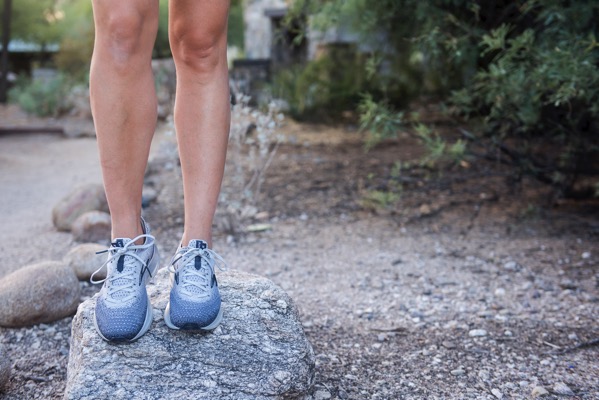
The Levitate 2 has fascinating energy return technology called DNA AMP. It takes the amount of energy you push into the shoe, and pushes back, giving you the feeling like it’s propelling you forward. It’s AMAZING. I feel light and bouncy on the trails, even though it’s been quite a while since these legs have seen longer than a mile run.

The DNA AMP cushioning system is revolutionary; Brooks is the first to create a system that gives each runner a push-off that corresponds to their unique gait and stride. I can already tell that these will be the running shoes I live in until it’s time for another pair.
Brooks also sent me some of their running apparel to test out. The Array Long Sleeve Tee is going to be the perfect fall top. It’s super lightweight and has an open back for ventilation. Even though it was hot outside when we took these photos, I wasn’t sweating too much since the shirt is so lightweight.

I also chose the Circuit 3″ 2 in 1 short. While they’re designed for running – they’re a flattering longer inseam and are DriLayer to wick away sweat – I’ve been using them for strength training, too. The inner liner is perfect for squats and leg work since you don’t have to worry about your shorts riding up. 
Since I’m slowly getting back in the running game, I thought I’d share some of my tips for returning to a running routine after a hiatus.
(Friendly reminder: if you’re recovering from an injury or making any fitness changes, be sure to talk to your doctor first.)
– Don’t compare yesterday’s successes to today’s progress. I may not run a half marathon in the near future, and my during my last half marathon, I PR’ed. My first few miles back were SLOW, but I felt great. For now, I’m taking it day by day and focusing on adding mileage gradually, without a specific pace goal in mind. In the past, it was always about running faster and longer, and now, it’s more about running for mental clarity and enjoying the fresh air. It feels SO restorative to be outside, exploring new sights hearing the wind rustle or birds singing.
– Start with walking and add in running intervals from there. My walking distance has been strong this entire time, so I started adding in 1 minute of jogging for every 3 minutes of walking. From there, I took it down to 1 minute of jogging every 2 minutes of walking. Then, 1 minute of each. After that, it felt good to jog the entire time. Don’t be afraid to take walk breaks when you need them, and avoid starting out too fast.
– STRETCH. I don’t recommend static stretching before running – instead, try foam rolling and dynamic stretches – but afterwards, it feels amazing. I especially take the time to stretch my hamstrings, quads, IT band, hips/glutes, and calves.

– Alternate running days with off days or cross training days. Strength training is an incredible complement to a running routine because it can help to increase performance while decreasing potential for injury. Recovery is critical for improvement, maintaining excitement for your routine, and preventing overtraining, so be sure to have at least 1-2 days off from formal exercise each day.
– Have an awesome playlist… or no playlist at all.  I like to have a playlist or podcast ready to go, but wait to use it until I need a little pep in my step. Sometimes I get all the way back home and remember that I forgot to turn on my playlist. Every now and again, a silent run is everything I need to fill my energy cup.
I like to have a playlist or podcast ready to go, but wait to use it until I need a little pep in my step. Sometimes I get all the way back home and remember that I forgot to turn on my playlist. Every now and again, a silent run is everything I need to fill my energy cup.
So, tell me, friends: did you get back into an activity or sport after a hiatus? Anything you’re doing now that’s new in your routine?
Hope you have a wonderful day and I’ll see ya soon!
xo
Gina
Photos: Jacquelynn Buck
The post Back in running action appeared first on The Fitnessista.
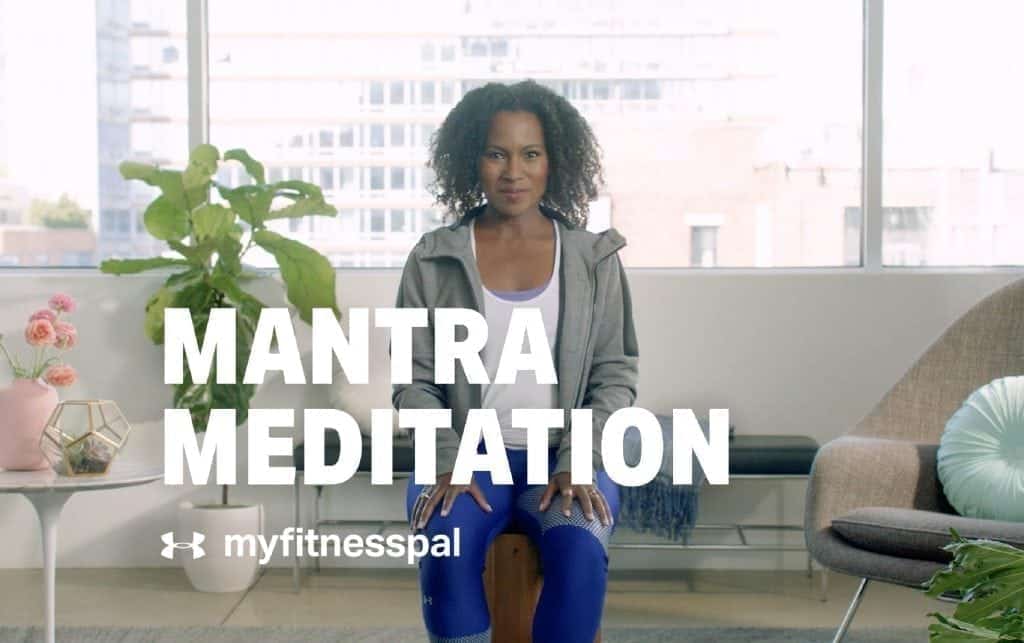
Om. The word is only two letters and one syllable, but can be incredibly powerful when used as part of your meditation practice. Om.
The post Mantra Meditation appeared first on Under Armour.
I was recently looking at photos from my best friend's bachelorette party in New Orleans and came across a picture of my best friend and her sister posing at our crawfish boil (yum). But it wasn't their gorgeous faces or the insane amount of food in the photo that caught my eye—it was myself in the background.
When the photo was taken, I must have been checking my email or responding to a text. My neck and shoulders were hunched forward, and my face was hovering inches over my phone. My back looked oddly rounded, and even though I'm terrible at estimating how tall people are, even I could tell that the way I was standing made me look several inches shorter than my real height of 5'6".
Honestly, my posture was painful to look at—and it's painful to experience too. A few hours into every workday, I find myself dealing with pain in my back, neck, and shoulders—and when I try to straighten up, it's like my muscles don't want to cooperate.
"Good posture is one of the most important controllable factors in optimizing spine health and preventing possible conditions from forming," says Robert Koser, D.C., of the Laser Spine Institute. "Besides improving your overall self-image and confidence, proper posture also helps develop stronger core muscles and prevents muscle fatigue."
Seeing that photo was a wake-up call. I don't want to look slouchy forever—or experience the pain that goes along with said slouching—so I talked with the experts to figure out how to straighten up and get my posture in line (pun intended!) once and for all:
I may have been horrified when I saw that photo of myself, but I'm hardly the only one struggling with posture issues. Because we spend the majority of our day sitting and staring at our computer or phone (the average American spends a whopping 10 hours per day staring at a screen), bad posture is pretty much a universal experience.
"Sedentary behaviors such as prolonged sitting without standing breaks or constantly looking down at a cell phone screen can be very detrimental," Koser says.
"Short term, you'll develop muscle tightness, which can lead to a restricted range of motion in your joints," says Ellen Bunn, PT, DPT. "Then, you may become susceptible to a variety of musculoskeletal conditions. For example, if your shoulders start to round forward, when you go to reach overhead, you may develop shoulder impingement. If your back is not supported with a strong core, when you move, you may injure your back. And your neck may get tight, resulting in musculoskeletal strain or even injuries to the intervertebral discs."
"The way you hold your neck determines how much pressure is placed on your spine, and for every inch you lean your head forward, 10 pounds of added pressure is placed on your spine," Koser says. "Over time, poor posture may cause chronic shortening of certain muscle groups and may even contribute to certain aches and pains down the road—poor posture may even cause the early onset of osteoarthritis or degenerative disc disease."
So, the bad news is, most of us have bad posture—and that can have seriously negative effects on our health. But the good news? With a bit of conscious effort, you can change this (and look and feel better as a result).
Here are some tips for getting your posture "back" in line (sorry, had to); straightening your spine; and kicking your back, neck, or shoulder pain to the curb:
"The first step is possibly the hardest but also the most important—and that's becoming very aware of your posture," Bunn says. "Having a way to remind yourself of good posture frequently throughout the day is perhaps the best way to get started… you could set some reminders on your computer or wear a Fitbit that vibrates when you've been sedentary too long. These external reminders are great ways to bring our awareness back to our posture."
If you really struggle with posture awareness, you could also invest in a posture wearable like Lumo Lift, which vibrates every time you slouch and reminds you to sit or stand up straight.
If you needed another excuse to get your plank on, here you go—working on your core muscles can help you improve your posture.
"Strong abdominal and back muscles, also referred to as core muscles, act as a built-in brace for your spine. Exercises such as squats, crunches, and chest lifts may help bolster core strength," Koser says. "Low-impact exercises such as yoga, Pilates, and tai chi can help you practice holding muscles in particular positions, which can develop better core endurance."
In an ideal world, none of us would have to sit at desks all day. But the fact is, a lot of us do (myself included!). So if we want to improve our posture, we've got to work with what we've got and maximize our office spaces to be as posture-friendly as possible.
"An ergonomic assessment will enable you to determine if your work setup is good for your body," Bunn says. "If you're sitting at a chair or desk that is too high or too low for you, attaining good posture may be difficult no matter what you do."
You also need to be aware of where you set up your computer. "For most individuals, adjusting your computer monitor 20-30 inches out in front of you and just below eye level while sitting up straight and having your knees close to a 90-degree angle is an ideal setup," Koser says.
Once you've got the right chair, desk, and computer setup, add a little cushioning to keep your posture on point. "If you are sitting for many hours during the day, try using supportive spinal cushions to maintain good posture," Koser says.
One of the best ways to alleviate the pain from bad posture and get yourself straightened up and back on track? Stretching.
"The most important things to stretch are your hips, back, and neck. When we sit for prolonged periods of time, our hips often become very tight, and we lose hip extension range of motion," Bunn says. "Additionally, we can start to get tight in the front of the chest, and we lose strength in our back extensors and core. A flexibility program of stretching hip flexors and chest openers in combination with a good back/core strengthening program is the best way to maintain good posture."
So which specific stretches can help?
"Upward-facing dog is a great stretch because it's a position in which both your back and hips are in extension," Bunn says. "When seated, your hip flexor muscles tend to get very tight. Bow pose is also really effective because, in addition to getting back and hip extension, you are also getting a shoulder stretch and engaging your neck extensors. Finally, performing a 'chin tuck' in which you draw your head back can help prevent forward head posture."
For more posture-improving stretches, check out the Physera app—search for "Posture with Yoga."
If you make strides to improve your posture and aren't seeing results, it may be time to talk to your doctor.
"If weeks or months of conservative treatment—including chiropractic care, physical therapy, postural exercises, and medications or injections—don't provide the relief you need for a good quality of life, it may be time to consult with a medical professional about more interventional care options," Koser says.
I've been incorporating these tips for a few weeks, and I've gotta say—I can see and feel a huge difference. This weekend, I'm leaving for my bachelorette party—and this time around when I look at the photos, my slouchiness is going to be the last thing I notice.
Deanna deBara is a freelance writer and accidental marathon runner living in Portland, OR. Keep up with her running adventures on Instagram @deannadebara.
Ever see a long, skinny boat with 20 people, a drummer and a steerer – and wonder what the health? This is dragon boating.
The post Finding Fitness: Dragon Boating appeared first on Under Armour.
How do a create a workout plan for maximum results?
How do I combine the classes I love into a solid plan?
How can I make sure I’m getting enough cardio, strength, and rest?
This is something that used to completely mystify me when I first got started in the fitness world and something I’m so passionate about today:
putting together and creating effective, sustainable fitness plans.

In this episode, I break down the science (and the art!) of putting together a great plan, especially if you love to take fitness classes and/or are strength training without seeing results.
Here’s what you’ll learn:
-How much cardio you REALLY need
-Typical muscle training splits and how to put them together
-Reps and sets for various goals
-My favorite exercises if you’re looking for physical changes
and
some of the mistakes I typically see as a personal trainer.
As always, check with a doctor before making any fitness changes. If you have any questions about form cues or have particular health considerations/injuries, please reach out to a local certified fitness professional for a full assessment.
I created a how-to just for you for this episode. If you’d like to print it out and use it for creating your own fitness plan, here is the sign-up:
If you love the info but would prefer to have someone else (me!) create your plan, get on the waiting list for our next round of Fit Guides here. <3
Thank you so much for listening! If you enjoyed the show, please consider leaving a rating and review on iTunes. It helps to increase the visibility of the podcast so more people have access to these healthy living tips.
Listen and subscribe on iTunes, Stitcher, and Google Play.

For full podcast notes for all episodes, check out fitnessista.com/podcast
The post 007: How to set up a workout plan appeared first on The Fitnessista.
This total-body workout focuses on heavy lean muscle-building strength work. All you need is a pair of dumbbells and a heavy barbell.
Hey friends! How are ya? Hope you’re having an amazing morning so far. Yesterday was spent at Costco stocking up on all the healthy treats, grabbing shaved ice at Bahama Bucks, and late-night swimming at Uncle E’s. I also caught a quick but intense strength workout + my first Peloton workout since they hauled my spin bike into the moving truck destined for storage. It felt SO good to be back… and to shake my legs out after filming Saturday’s videos.
I’ve been following the Lean Machine program pretty closely, modifying for one Orangetheory or barre workout each week. Whenever I stick to a dedicated muscle split, I see results quickly and can notice measurable strength gains. Total body workouts are more rare, but when they occur, I focus on heavy strength with a couple of built-in intervals.

We’re relaunching the Fit Guide workouts this fall with tons of new surprises for you, so if you didn’t catch it on the first round, be sure to hop on the waiting list here. Lean Machine is perfect if you’re looking to build lean muscle and follow a solid split, or you can check out a handy quiz here to find a great *fit* for ya.
For today, I’m sharing a workout named after the Lean Machine plan, focusing on heavy strength, but working your entire body instead of splitting up the muscle groups.
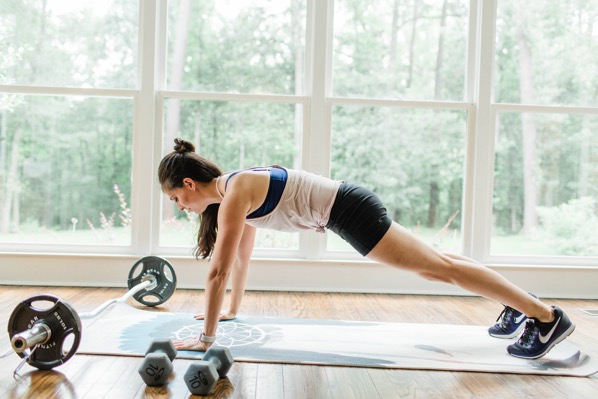
Try to really challenge yourself with the weights on this one – I had minimal equipment when we took these pics because everything was being packed up! – and try to find a weight that makes you really breathe and push yourself to finish each set with proper form. As always, check with a doctor before making any fitness or nutrition changes and honor your body. Modify as needed.

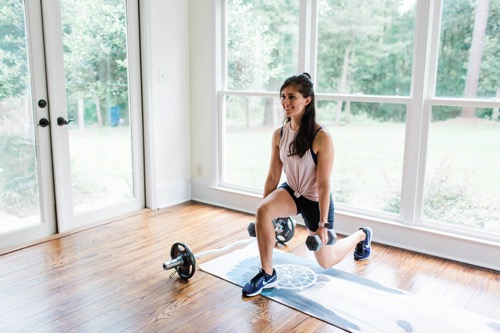
Low lunge to squat: For this exercise, you aren’t rising in between switching – keep your body LOW and knees bent the entire time. Torso stays upright, step back into your lunge, then keep the front knee bent as you step out to the side to squat. Step the opposite foot behind and lunge. Watch the front knees to make sure they don’t extend past the toes.
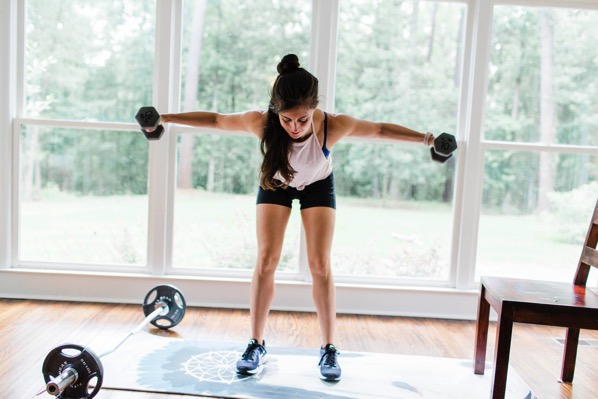
Reverse fly: Your feet will be just under your hips with a slight bend at the knees. Hinge forward from your hips, keeping your back flat (shoulders pulled back) and core braced. Open your arms straight out to the sides, squeezing your shoulder blades together, then bring them back down with control.

Barbell row: Your feet will be just under your hips with a slight bend at the knees. Hinge forward from your hips, keeping your back flat (shoulders pulled back) and core braced. Lifting up from your elbows, bring them in towards your torso, engaging into your rear delts. Stop the elbows in line with your torso before carefully lowering back down.
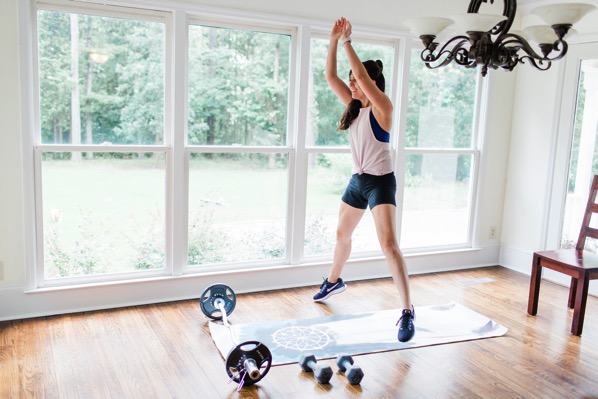
Plie squat jumps: Get into a plie squat position (feet wide and booty LOW), and touch the floor. Keep your abs engaged and chest lifted. Powering through your heels, spring up, reaching your arms towards the ceiling. Land with a soft knee. Repeat
Hammer curls: Hold a pair of dumbbells by your sides, palms facing in. Bend your elbows as you lift them to your shoulders and return to start.
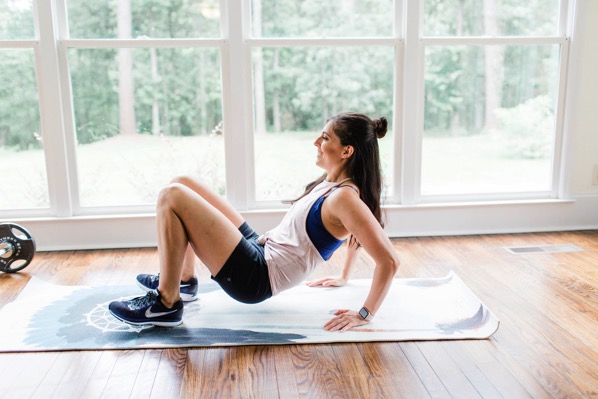
Triceps dips: Place your hands on a bench behind you, or you can perform these on the floor as I have in the pics above. Either bend your knees with your feet flat on the floor or straighten your legs in front of you for more of a challenge. For even more of a challenge, place a flat plate on your legs. Bend your elbows straight back and keep your back close to the bench. Keep your chest lifted and shoulders down. Push back to start.
Decline push-up: Place your shins on a bench and walk your hands out into a plank position. With your core engaged and hips in line, lower into a pushup. Squeeze your chest as you push back to start.
Chest press: Start on your back with legs bent and feet flat on the floor. Hold the weights out to your sides at 90 degrees. Press the weights in front of your chest, performing a chest press.
So, tell me, friends: do you follow a strength training plan, or do you wing it? If you wing it, be sure to check out tomorrow’s podcast episode (I’ll post it here on the blog, too) because it’s all about how to set up a workout plan.
Have a wonderful morning and I’ll see ya soon!
xo
Gina
Photos: Lindsay Colson
Wearing: Fabletics tank and lululemon shorts
The post Lean machine total body appeared first on The Fitnessista.
Next to sugar, salt might be one of the most vilified ingredients in our diets. Practically every resource says we should be eating less of the stuff because it can lead to major health problems. But does that actually mean that the best thing to do is give up salt completely?
The answer might surprise you. While most people need to cut back on salt and sodium (and yes, the two are different!), our bodies still need the stuff to function. What’s more, getting rid of the salt shaker on your kitchen table probably isn’t the most effective way to get your intake in check.
Here’s the real deal on salt, including when it’s good and when it’s bad. Plus, answers to your other salty questions—like whether salt makes you thirsty and whether that pricey pink Himalayan stuff is really a health food.
The two are often used interchangeably, but they’re actually a little different. Sodium is a mineral, and small amounts are found naturally in foods like milk, beets, and celery. It’s also added—in much larger quantities—to packaged foods, both for flavor and as a preservative. In fact, around 75 percent of the sodium we get comes from packaged or processed foods, according to the American Heart Association.
Table salt, on the other hand, is a combo of the minerals sodium and chloride. Salt consists of 40 percent sodium and 60 percent chloride, with a teaspoon of the stuff packing around 2,300 mg (that’s a day’s worth) of sodium.
Even though it gets a bad rap, sodium is essential for our health. “It’s an electrolyte that helps transmit nerve impulses and maintains fluid balance. It also affects muscle’s ability to contract and relax,” explains Becky Kerkenbush, MS, RD-AP, media representative of the Wisconsin Academy of Nutrition and Dietetics. In other words? If you were to cut salt out of your diet completely, you’d be in bad shape.
The problem comes from getting too much. (Which can be easy to do, because hey, salt makes food taste good!) The body only needs 500 mg of sodium per day—but the average American gets around 3,400 mg. And going overboard can lead to health issues. Excess salt causes your body to hold onto extra water, which increases your blood volume. That puts more pressure on your blood vessels and forces your heart to work harder. Eventually, this sets the stage for high blood pressure, heart attack, and stroke.
Limiting your sodium intake to a measly 500 mg daily would be tough—not to mention leave your food pretty bland. Fortunately, almost no one needs to keep their intake quite that low.
The most recent Dietary Guidelines for Americans recommend that adults consume fewer than 2,300 mg sodium daily. But some people need to eat less. If you have high blood pressure (or are at risk for it) or diabetes, you should keep your sodium intake below 1,500 mg daily.
Other serious health problems—like heart failure, kidney disease, heart disease, or lymphedema are also cause for curbing your sodium consumption, Kerkenbush says. Your doctor or a registered dietitian can help you determine how much sodium is safe to have.
Sure, limiting your use of the salt shaker or finding salt-free ways to flavor home-cooked food both help. But remember, packaged foods account for a whopping 75 percent of our sodium intake. So you’ll automatically trim a ton of excess sodium from your diet just by limiting your consumption of the processed stuff. It’s worth paying attention to the sodium content for these foods, in particular, which the CDC says account for around 40 percent of our sodium consumption:
Sodium is excreted through sweat. So if you work out to the point where you’re really drenched, you might need a little more than usual. But that’s the exception, not the rule. “Most recreational exercisers get plenty of salt in their diet, so sticking with the 2,300 mg recommendation is sufficient,” says Allison Childress, Ph.D., RDN, director of nutritional sciences at Texas Tech University. You don’t need a chug a sports drink after a 30-minute jog or a 40-minute bike ride.
If you’re an elite athlete or you’re exercising for long periods of time (say, an hour or more), or you’re working out in extremely hot weather, some extra sodium might be warranted, Childress says. How much depends on factors like the length and intensity of your workout, but a sports dietitian can help you find your sweet spot.
Most of us assume that eating lots of salt will make you thirstier. But the opposite seems to be true, according to recent findings. When German researchers had subjects eat a low-, medium-, or high-salt diet, they found that those who were given more salt tended to drink less. In fact, eating more salt seemed to trigger the body to hang on to more water.
Experts are still figuring out how this fits into the context of our overall health. In the meantime, the best thing to do is to just listen to your body, Childress says. If you find that you’re parched after a salty meal, drink up. But if not, you don’t have to force yourself to guzzle extra liquid.
How does plain old table salt stack up against Kosher salt, sea salt, or trendy options like pink Himalayan salt? From a health perspective, there’s not much difference. “They contain similar amounts of sodium by weight,” Kerkenbush says. And while it’s true that some sea salts may contain more trace minerals than table salt, the amounts are pretty negligible.
That’s not to say fancier salts aren’t worth using. When sprinkled on top of a finished dish, flaky sea salt adds a crunchy texture that table salt can’t replicate, for instance. And some people simply prefer the flavor of certain salts to others.
The bottom line? Cook with the salt that you like best. Like with different types of sweeteners, your body can’t tell much difference between one type of salt and another. So go ahead and use your favorite—in moderation.
Don't smoke. Don't skip the sunscreen. Don't skimp on beauty sleep. These are the rules we've been taught to follow if we want to hold onto happy, youthful skin—but we could be sabotaging ourselves without even realizing it.
Expensive moisturizers, masks, creams, and serums aren't necessarily a great investment if we drop the ball when it comes to other areas of our lives—and we aren't talking about pulling the occasional all-nighter. Here are a few ways your everyday routine could be making you look older.
Do you ever notice how you wake up with creases on your face after a good night's sleep? "Many people sleep on their face, which can cause sleep lines or wrinkles," says dermatologist Marie Jhin, M.D. of Premier Dermatology. "I love silk pillowcases—they can help with this."
And they're not even as crazy-pricey as you might think, given that they're made out of silk. A high-quality, 100-percent pure silk pillowcase from Alaska Bear will set you back $23, which ain't a bad investment. And bonus: It's also better for your hair.
A $6 Moscow Mule is hard to resist, especially after working a grueling eight-to-nine all week. Drinking booze in moderation has its benefits, including an increase in your HDL cholesterol levels (that's the good kind), as well as lowering your risk of Alzheimer's and dementia. But indulging in more than one or two glasses a day can undo all those amazing benefits.
Pouring it up too much reduces the amount of collagen (a protein that keeps your skin looking supple) and causes redness brought on by dilated blood vessels. "Consuming too much alcohol is definitely something that can have an effect on the skin because of how dehydrating it is," says Maggie Michalczyk, RDN, founder of Once Upon a Pumpkin. "The alcohol is pulling moisture out of the skin, and this dehydration works to speed up the process of wrinkle definition and inflammation to the skin."
Doing the absolute most 24/7 might impress your boss, but it's likely wreaking havoc on your health. When you multitask, your body experiences higher amounts of stress than when you apply your focus to one task at a time.
"Chronic stress may affect the skin in adverse ways, especially in aging," says William Kwan, M.D., a board-certified dermatologist and ethnic skin care expert in San Francisco. "Stress can lead to an increase in inflammation in the skin. This inflammation releases mediators, which can destroy collagen and connective tissue, possibly affecting epidermal maturation."
Freezing one minute, hot like a sauna the next? Back-and-forth temperatures are annoying AF, but overusing your central air and heating system dries out your skin because all the moisture is sucked out of the air in your home or apartment, making fine lines and wrinkles even more noticeable. "Dry skin leads to inflammation," says Dina D. Strachan, M.D., a board-certified dermatologist and director of Aglow Dermatology in New York City. "We lose collagen and elastin in our skin with age. Inflammation accelerates this process."
If you absolutely need to crank up the AC or heating system, give your skin a dose of TLC with a super-hydrating night cream, like the Lavender Age Corrective Night Concentrate from Eminence Organics. Drink plenty of H2O and consider getting a humidifier and placing it in your bedroom, living room, and wherever else you spend the most time as well.
Not all fats are created equal. Unlike trans fats, for instance, monounsaturated and polyunsaturated fats are "healthy" fats—and they're great for your skin, says Deepa Verma, M.D.
"Fats have been demonized," Verma says. "But we actually need them—they're building blocks for hormones and are responsible for cell membrane integrity, and getting enough good fats can result in healthy, glowing skin."
So what are some sources of the right kind of healthy fats that will make our skin glow? "Avocados are associated with anti-aging due to the compound xanthophyll, and they also have vitamin E, which provides skin with increased collagen synthesis and elasticity," Verma says. "Sunflower seeds are another good one—they have vitamin E, and are a rich source of selenium and copper, which help maintain youthful and radiant skin. They're also packed with omega-6 and linoleic acid, which help with skin cell regeneration."
And don't forget to get your omega-3s too. "Omega-3 can be derived from fish, but there are plant sources as well, such as chia, flax, and ahiflower," Verma says. Certain omega-3s can block the release of UV-induced enzymes that degrade collagen, which cause lines and sagging skin—basically, sources of omega-3 can help prevent and repair sun damage.
We grew up watching our mothers and grandmothers spritz perfume on their "pulse" points—neck, wrists, and décolletage. They're full of wisdom about life's lessons, but the skin on your neck is delicate, so applying perfume to that area is a no-no.
The alcohol in fragrances is super drying—and can be especially problematic if you spray it on right before stepping out into the sunlight, which puts you at a higher risk of developing a skin condition called Poikiloderma of Civatte, which is basically skin discoloration due to prolonged periods of sun exposure.
"Perfume can contribute to this skin condition, as some of the ingredients react to UV exposure, creating a toxic molecule to the skin," explains Ava Shamban, M.D., a dermatologist in Santa Monica and founder of SKINxFIVE. Instead, try spritzing a brush and running it over your forearm, clothes (avoid silk and other delicate fabrics), and hair. Shamban also suggests using sunscreen and clothing (i.e., lightweight scarves) to shield the sensitive skin on your neck and décolletage against damaging UVA and UVB rays.
Straws fight off teeth stains and minimize cavities, but the downside? The "repetitive motion" of pursing your lips can cause wrinkles to form around the mouth, Shamban says. Our solution? Skip the straw and try one of these teeth-whitening tricks instead.
Princess Gabbara is a multimedia journalist and storyteller. Follow her on Twitter and Instagram @PrincessGabbara.
This article was written by Viome, the most comprehensive gut microbiome test on the market.
Poor carbs—they get such a bad rap. Diets like Atkins and keto have turned foods like bread and pasta into guilty pleasures, forcing us to replace them with sad substitutes like cauliflower and zoodles. But what if you don’t have to give up your beloved carbs to feel good?
It might all come down to your microbiome—yep, those tiny organisms living in your digestive tract. As the only test on the market that can see exactly what’s going on in your gut, Viome can find out if you have the microbes needed to digest carbohydrates well.
One of the reasons carbs get a lot of flack is because they jack up your blood sugar, causing your body to produce insulin. Insulin is a hormone produced by the pancreas that regulates the amount of glucose, which comes from carbohydrates, in your blood. Insulin delivers glucose, our bodies' main energy source, as fuel to our cells.
But if you eat carbs (especially simple ones like sugar) too often, you become less sensitive to insulin and your pancreas has to make more and more of it to get the same effect. Over time this can lead to insulin resistance, type 2 diabetes, and thyroid problems.
But an interesting study shows not everyone reacts to the same meals in the same way. Researchers looked at the blood-sugar levels of 800 people over the course of a week and found they responded to foods in dramatically different ways. For instance, one person’s blood sugar spiked after eating bananas but not cookies (lucky!), whereas someone else experienced the exact opposite (sorry, dude).
Now here’s where things get really interesting: The scientists also looked at the participants’ microbiomes and found there was a strong correlation between their gut bacteria and their blood-sugar spikes. They then took those findings—plus other lifestyle and health factors—and created an algorithm that can pretty successfully predict how people will react to meals. Not only that, but they were also able to use the algorithm to create personalized diets that can help control blood sugar—and some of those plans included booze and chocolate!
TL;DR: Everyone reacts to carbs differently—and the bacteria in your gut might be a major reason why.
Consider trying Viome. It’s a gut-health test that will tell you whether you have the microbes to metabolize carbohydrates and give you recommendations on the best foods for your microbiome—plus provide you with appropriate serving sizes. Many of Viome’s customers are shocked—and thrilled!—when they find out they have the right little guys to break down their favorite pizza or pasta.
Viome is the only company using a fancy thing called metatranscriptomic sequencing technology, which means it can see not only what microbes are active but also what they are producing and what food sources they’re using. After Viome finds out what’s going on in your gut, its expertly trained AI machine crunches the numbers and gives you precise, individualized results.
Viome’s goal is to put the power back into the hands of the people by giving you the information you need to supply your body with the nutrients unique to you and your gut microbiome.
For a super-limited time, Greatist readers can get $100 off a Viome kit when they use code GREATIST12 at checkout.*
This is part of Greatist's series with Viome and was reviewed by the Viome experts listed below. Stay tuned to find out what else Viome can show you about your gut and learn more about Viome here.
*Greatist receives an affiliate fee on purchases made. Offer valid through July 31, 2018, 11:59 p.m. PT.
This article was written by Viome, the most comprehensive gut microbiome test on the market.
You probably feel pretty good about yourself every time you load up your smoothies, salads, and grain bowls with spinach. (Us too.) After all, it’s a superfood, so it’s gotta be healthy. But the thing about spinach—and many other “healthy” plant-based foods—is they contain a little thing called oxalates, which can cause kidney stones or keep you from absorbing certain nutrients.
Oxalates are naturally occurring salts produced by the body and most plants. Though we don’t know for sure, many think they’re what give plants their bitter taste, probably to protect them from predators like, well, us. Amounts vary, but they’re found in pretty much every plant-based food, from rhubarb and beets to nuts and dark, leafy greens like spinach. Your body can also convert vitamin C into oxalates, which means fruits like berries and kiwis, which contain both oxalates and vitamin C, can be double trouble.
Here’s the thing: Oxalates in and of themselves aren’t bad. For most people, oxalates from food join up with minerals like calcium and iron and exit your body when you go to the bathroom—or they get broken down by bacteria in the gut (more on that later).
If you’d actually heard the word oxalate before today, it was probably in the context of kidney stones. That’s because calcium oxalate stones are the most common type—and they’re just what they sound like: calcium + our good friend oxalate. The two should be able to hang out in the kidneys together, but when there’s too much oxalate or too little liquid in your urine, they combine to create crystals, which can stick together to become kidney stones (ouch!).
Another problem with oxalates is that when they latch onto minerals, they can keep you from reaping the benefits of those nutrients. For instance, even though spinach is high in calcium, its oxalates prevent some of the calcium from being absorbed (though it's worth noting that if you were to drink a glass of milk with your spinach, you'd still get all the calcium from the milk).
The good news is some oxalates are broken down by bacteria in the gut. The bad? Not everyone has the right bacteria for the job. Perhaps the most well-researched one is Oxalobacter formigenes. Though some members of Lactobacillus and Bifidobacterium species may play a role as well, O. formigenes is known to metabolize oxalate, and studies suggest it can help reduce the risk of kidney stones. But as with most bacteria, antibiotics can kill off these good guys, potentially leaving your gut defenseless.
Viome, the most comprehensive gut microbiome test on the market, analyzed tens of thousands of people and discovered that about 30 percent of them lacked the microbes necessary to metabolize oxalates properly. In other words, “healthy” foods like spinach may not actually be healthy for them.
Not necessarily. Many foods that contain oxalates are good for you and packed with nutrients. But it’s true some people are more sensitive to oxalates. For example, if you have a digestive issue like inflammatory bowel disease or have had gastric bypass surgery, oxalates are more likely to build up in your kidneys. Viome has also found that a low-oxalate diet may help people with digestive issues.
The fact is everyone is different. If you really want to know what your body can handle, consider Viome. Viome is the only gut microbiome test able to analyze your gut at the molecular level to see if your microbes actually metabolize the foods you’re eating. This is because Viome uses metatranscriptomic sequencing technology—a technical way of saying it has the power to see not only your microbes but also what they are metabolizing, producing, and using.
After Viome finds out what’s going on in your gut, its expertly trained AI machine crunches the numbers and gives you precise, individualized results. In other words, you’ll find out whether spinach is actually healthy for you.
Viome’s mission is to put your health back into your own hands by providing personalized dietary recommendations that empower you and restore your body to its innate purpose.
For a super-limited time, Greatist readers can get $100 off a Viome kit when they use code GREATIST12 at checkout.*
This is part of Greatist's series with Viome and was reviewed by the Viome experts listed below. Stay tuned to find out what else Viome can show you about your gut and learn more about Viome here.
*Greatist receives an affiliate fee on purchases made. Offer valid through July 31, 2018, 11:59 p.m. PT.
This article was written by Viome, the most comprehensive gut microbiome test on the market.
First it was fat-free. Then it was low-carb. And now? High-protein. You can’t walk down a grocery-store aisle without seeing high-protein pasta, ice cream, bread, cookies, and even beer.
It’s no secret protein is important—it helps build muscle, makes you feel full, and basically keeps you alive. But it turns out not everyone should be going HAM on it (pun intended). As with most things, it all comes down to your gut health.
Before you start devouring protein powder by the bucketful, you might want to make sure your gut is up to the task. Why? Because high-protein animal foods like beef or eggs contain the C-words: choline and carnitine. Choline is a super-important nutrient that ensures cells, the brain, and the nervous system function properly, whereas carnitine helps the body produce energy.
So… what’s the problem? Well, once these guys hit the gut, certain bacteria break them down into something called trimethylamine (TMA). TMA then makes its way to the liver where it gets turned into TMAO—and that’s where things get tricky. More research is needed, but some studies have linked TMAO to a higher risk of heart and kidney disease—and possibly even type 2 diabetes.
One small study looked at 18 people—eight of which were vegetarians/vegans—and gave them daily choline supplements for two months. In both groups, TMAO levels were 10 times higher, and the participants’ blood became stickier, making it more susceptible to clotting. In other words, choline seemed to increase TMAO, which, in turn, increased the risk of blood clots.
Before you freak out about that omelet you had this morning, know that the verdict’s still out on the exact role TMAO plays in cardiovascular disease. And not everyone agrees that choline- and carnitine-rich foods are the culprit. For example, one meta-analysis showed that eating eggs (at least one per day) actually did not increase one’s risk of heart disease.
Some researchers think it might come down to what kind of bacteria you have in your gut. You’ve probably already heard a lot about gut health and how having a diverse microbiome (i.e., digestive tract) can help with everything from digestion issues to depression to sleep. But in this case, bacteria might be part of the problem.
One study fed both meat eaters and vegans/vegetarians an 8-ounce steak and a cartine supplement then looked at their TMAO levels. Researchers found that carnivores had high amounts of TMAO, whereas their veggie counterparts didn’t. Then they had the meat eaters take antibiotics to alter their gut bacteria, and when they fed them steak again, they found way less TMAO in their blood. This suggests bacteria is a major factor in how much TMAO your body produces—and that the fewer animal products you eat, the less likely you are to have that bacteria.
So before you go Paleo or jump on the carnivore diet, you may want to check your microbiome. This is where Viome comes in. Viome is the only gut test on the market that can actually analyze the activity of your microbes. By looking at how much TMA-producing bacteria you have—and what it's doing—it can let you know how much protein your body can handle and whether you need to cut back on red meat and eggs for a while.
What else does Viome uncover? It gives you precise and personalized recommendations on all the foods you should be enjoying and all the ones you should be minimizing, plus your ideal macronutrient breakdown.
Viome's mission is to put the power back in people's hands by giving your body the resources it needs to thrive.
For a super-limited time, Greatist readers can get $100 off a Viome kit when they use code GREATIST12 at checkout.*
This is part of Greatist's series with Viome and was reviewed by the Viome experts listed below. Stay tuned to find out what else Viome can show you about your gut and learn more about Viome here.
*Greatist receives an affiliate fee on purchases made. Offer valid through July 31, 2018, 11:59 p.m. PT.